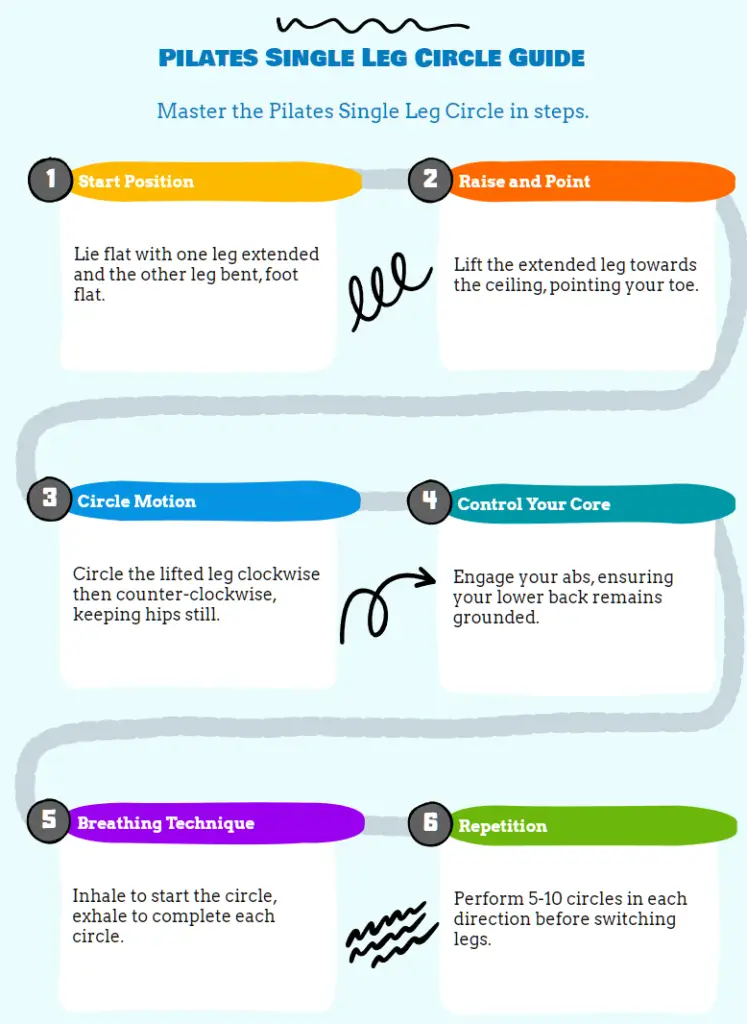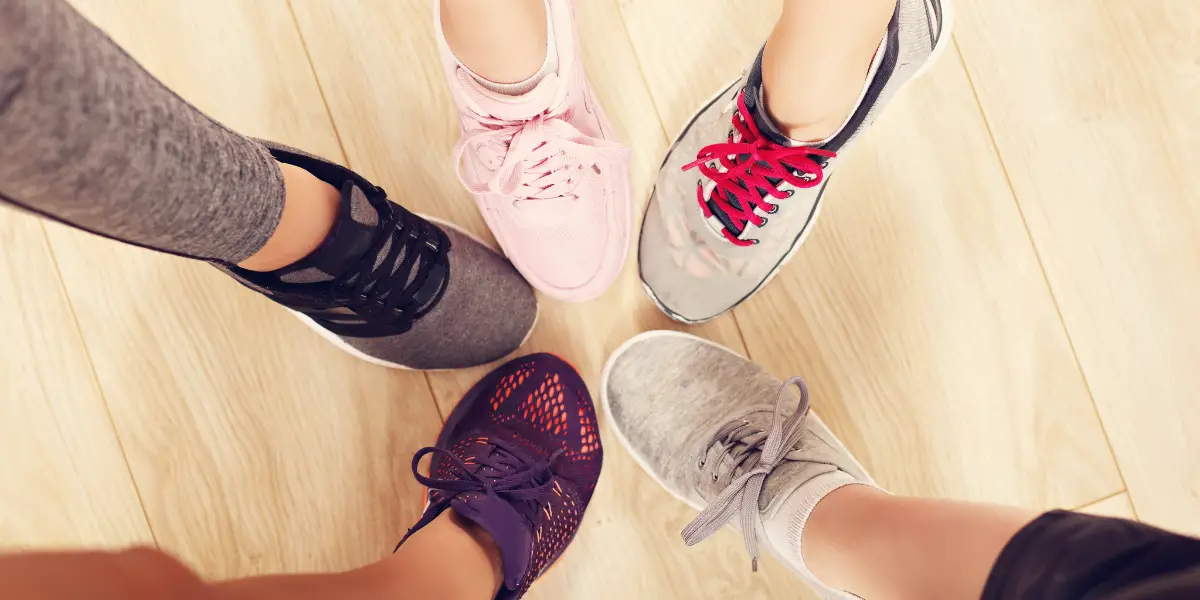While the simplicity of the single leg circle belies its intensity, you’ll find it’s a surprisingly effective core strengthening tool.
As you lie on your back, drawing circles in the air with your lifted leg, you’re not just sculpting your thigh; you’re engaging the powerhouse of your body—your core.
Each rotation demands stability from your abdominal muscles, hip flexors, and lower back, ensuring they work in concert. You’ll enhance your balance and coordination with this low-impact exercise, which can be tailored to your fitness level.
The Single Leg Circle is a highly effective Pilates exercise for core strength. It targets the abdominal muscles, hip flexors, and inner thighs, helping to improve stability, balance, and overall core strength. Practicing this exercise regularly can lead to a stronger core and improved body control.
So whether you’re a beginner or seasoned athlete, incorporating the single leg circle into your routine can yield significant gains in core strength and muscular control. Remember, it’s not just a leg workout—it’s a full-core challenge.
Understanding Single Leg Circles
The Single Leg Circle is a Pilates exercise that directly targets your core stability while simultaneously engaging the muscles of your elevated leg.
As a Pilates mat exercise, it strengthens not just your core but also enhances the flexibility of your hip joint. You’ll perform a controlled circling motion with one leg, challenging your abdominal muscles to maintain pelvic stability.
The opposite leg remains grounded and steady, contributing to the workout’s efficacy. Single Leg Circles are an excellent way to build core strength, which is vital for better posture, balance, and overall fitness.
Core Benefits Analysis
Every repetition of the Single Leg Circle significantly strengthens your core by engaging the deep abdominal muscles essential for stability and posture.
This Pilates exercise not only targets your core muscles but also maintains a stable pelvis and promotes a healthy hip joint.
As part of your core benefits analysis, consider how the Single Leg Circle serves as a multifaceted exercise enhancing your core strength.
| Benefit | Targeted Muscle Group | Contribution to Core Strength |
|---|---|---|
| Pelvic Stability | Lower Abdominals | Maintains a stable pelvis |
| Hip Joint Mobility | Hip Flexors | Fosters a healthy hip |
| Deep Core Engagement | Transverse Abdominis | Enhances posture and balance |
| Lower Body Coordination | Quadriceps & Hamstrings | Improves overall stability |
| Precision and Control | Entire Core | Integrates Pilates principles |
Through consistent practice, you’ll notice improved balance and stability, hallmarks of a strong, functional core.
Step-by-Step Execution
Before starting the Single Leg Circle, you’ll want to ensure you’re lying flat on your back with one leg extended straight on the mat.

This Pilates exercise targets your core, so maintaining correct form is crucial. With your other leg raised towards the ceiling, initiate the movement by rotating from the hip. Keep your pelvis level and avoid rocking—stabilization is key.
Begin a controlled circle by moving the extended leg across your body, then sweeping it down towards the floor, and finally lifting it back up to complete the rotation.
Perform this step-by-step execution smoothly to prevent momentum from taking over. Focus on keeping your shoulders and neck relaxed throughout.
Repeat the circle 5-10 times before switching legs to ensure balanced core strength development.
Common Technique Errors
Avoiding common technique errors when performing Single Leg Circles is crucial for maximizing core strength benefits and preventing injury.
The Single Leg Circle targets your core, but improper form can lead to ineffective results and potential strain.
| Common Errors | Consequences |
|---|---|
| Lifting shoulders or pelvis | Reduced core engagement |
| Non-working leg bent | Compromised stability |
| Moving the opposite shoulder | Less effective workout |
| Failing to keep the circle | Poor muscle targeting |
| Jerking the upper body | Increased risk of injury |
Ensure the non-working leg remains straight and grounded. Keep your shoulders and pelvis stable as you move the leg up toward the ceiling; this stabilizes your core. Always bend the knee slightly if you cannot maintain a straight leg throughout the exercise. Remember, precision in movement ensures strength in results.
Modifications and Progressions
As you become more comfortable with the Single Leg Circle, you’ll find that various modifications and progressions can further enhance your core’s strength and stability. A physical therapist or Pilates Studio instructor can guide you through these adjustments.
Incorporate an exercise band to add resistance, making your muscles work harder.
Gradually increase the size of the circles as your flexibility allows, challenging your precision and control.
Keep both legs extended and add a Pilates curl for an advanced progression, ensuring you’re able to increase abdominal engagement.
These tailored changes won’t only boost the intensity of your workout but also ensure it continues to be effective as your strength and skill grow. Remember, the key is to listen to your body and progress at a pace that feels challenging yet manageable.
Safety Considerations
As you focus on strengthening your core with single leg circles, it’s crucial to prioritize injury prevention. Ensure you’re practicing proper form by keeping your shoulders and pelvis grounded and moving with control.
If you have existing health concerns, always consult a healthcare professional before adding this exercise to your routine.
Injury Prevention Tips
To prevent injury while performing the Single Leg Circle, it’s crucial that you’re aware of your body’s alignment and engage your core throughout the exercise. Here are vital injury prevention tips:
- Keep one leg closer to the body: When doing the Pilates Single Leg Circle, ensure the non-moving leg is grounded and, if needed, the knee slightly bent to maintain stability.
- Balance the weight evenly: Distribute your weight across your hips and shoulders to avoid straining one side of your body and promotes overall balance.
- Move with control: Avoid swinging your leg too far, which can lead to imbalance and strain. Move your leg in a controlled manner to strengthen the core effectively.
Proper Form Essentials
Ensuring you maintain proper form is crucial to safely execute the Single Leg Circle and maximize its core strengthening benefits. Keep your shoulders and neck relaxed to prevent tension; this allows you to focus on the leg and core muscles you’re aiming to engage.
As you circle your leg, make sure to keep your pelvis anchored and stable, preventing any rocking that could undermine the exercise’s effectiveness. Your knee should remain straight, but not locked, while circling, ensuring a smooth and controlled motion.
Don’t forget to engage your core by drawing the navel in and up, which provides the stability necessary for a proper Single Leg Circle. Remember, a steady upper body is key, so keep your chin down and your shoulders away from your ears.
Sources
https://www.verywellfit.com/how-to-do-one-leg-circle-2704673
https://www.sportskeeda.com/health-and-fitness/what-is-single-leg-circle-pilates-tips-technique-correct-form-benefits-common-mistakes
https://embodymovementpilates.com/single-leg-circle/
https://sacdt.com/blog/2011/08/pilates-exercise-of-the-month-single-leg-circles/




